 |
 |
 |
| |
PREVALENCE AND RISK FACTORS OF LOW GRADE PROTEINURIA IN HIV INFECTED PATIENTS
|
| |
| |
Reported by Jules Levin ICAAC Sept 2012
Andreas J. Zeder1, Robert Hilge1, Johannes R. Bogner1, and Ulrich Seybold1 1Medizinische Klinik und Poliklinik IV, Klinikum der Universitšt, Ludwig-Maximilians-University, Munich, Germany
· 518 patients were entered into the study.
· In 27 of them (5.2%) significant proteinuria of ≥500 mg/g creatinine was detected. They were excluded from the statistical analysis.
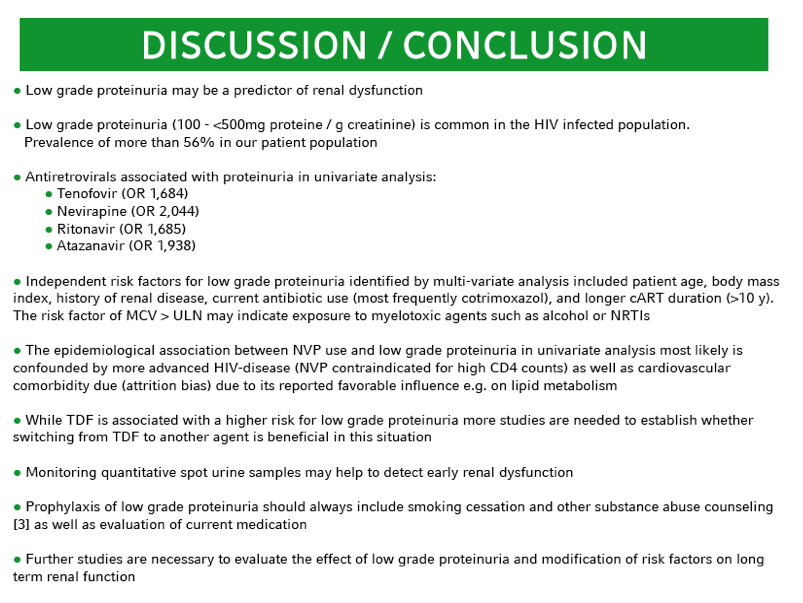
UPDATED ABSTRACT
· Background: Both HIV infection and drugs used for combination antiretroviral therapy (cART) are risk factors for chronic kidney disease (CKD). Low grade proteinuria may be an easily detectable indicator of early renal dysfunction in HIV-infected patients associated with potentially modifiable risk factors.
· Methods: Between January 2009 and February 2011 spot urine samples were collected from HIV infected patients in our outpatient clinic in addition to routine laboratory tests. Quantitative measurements included protein and creatinine. Demographic and medical information was abstracted from patients' charts. Variables associated with low grade proteinuria (100-499 mg/g creatinine) were identified.
· Results:
Significant proteinuria of ≥500 mg/g creatinine was detected in 27/518 patients (5.2%), who were excluded from the study.
Among 491 patients with a urine protein content of <500 mg/g creatinine 391 (79.6%) were male, 404 (82.3%) Caucasian, median age was 45 years (range 20-82). Median CD4 T-cell count was 500.5/μl, 41 (8.3%) had a CD4 count <200/μl. 161 (32.8%) had been diagnosed with AIDS, 442 (90.0%) received cART, of whom 402 (91.0%) had a viral load <50 cp/ml.
215 study patients (41.5%) had a urine protein concentration of <100 mg/g creatinine and 276 (53.3%) had low grade proteinuria of 100-499 mg/g creatinine.
Variables significantly associated with low grade proteinuria in univariate analysis included Caucasian race, hypertension, smoking, known renal disease, CD4 count <200/μl, HIV CDC stage C, and being on cART.
In multivariate analysis cART including tenofovir (aOR 1.9, 95% CI 1.2-2.9, p=0.03), patient age (aOR 1.05 per year, 95% CI 1.03-1,07, p<0,001), BMI<25 kg/m· (aOR 1.6, CI 1.1-2.5, p=0,24), current antibiotics (aOR 2.5, 95% CI 1.2-5.1, p=0.01), MCV > ULN (aOR 1.8, CI 1.1-1.9, p=0.02), duration of cART >10 years (aOR 1.7, 95% CI 1.1-2.7), and history of renal disease (aOR 5.7, 95% CI 1.6-20.3, p=0.007) were identified as independent predictors of low grade proteinuriain a model controlling for HCV infection and HIV CDC stage C disease.
· Conclusions: Low grade proteinuria is frequent among HIV infected patients and is associated with cART, specifically tenofovir. Monitoring quantitative spot urine samples may help to detect early renal dysfunction.
BACKGROUND
· Increasing incidence and prevalence of HIV infections worldwide [1]
· Increasing life span of HIV infected patients [2]
· Increasing median age of treated HIV infected population
· Increasing role of non-HIV comorbidities (e.g., renal and cardiovascular)
· Insufficient data for HIV-specific management of proteinuria
· Inadequate data with respect to prevalence, risk factors, and significance of low grade proteinuria in HIV infected patients
OBJECTIVES
· Determination of prevalence of low grade proteinuria in HIV infected patients
· Analysis of association of low grade proteinuria with HIV-specific patient characteristics
· Identification of independent risk factors for low grade proteinuria
· Establishment of data base for future prospective studies
METHODS
· Patient population: Consecutive HIV infected patients at the University hospital infectious diseases outpatient clinic
· Inclusion criteria:
Age ≥18 years
Confirmed diagnosis of HIV
≥2 visits to clinic during 2 years prior to examination
≥1 quantitative spot urine examination 2009-2011
· Exclusion criteria:
Confirmed diagnosis of:
-- Chronic glomerulonephritis, monoclonal gammopathy, Alport's Syndrome, systemic lupus erythematodus, sarcoid, amyloidosis, sickle-cell disease, or granulomatosis with polyangiitis
Acute inflammatory condition at day of sample collection:
Urinary tract infection
Fever ≥38,5°C
· Collection of spot urine samples in addition to quarterly routine laboratory tests
· Data Collection:
Review of patients' charts and electronic medical records
Extraction of demographic, epidemiological and medical data
Retrospective documentation of cART, co-medication, HIV-related and other comorbidities
· Statistical analysis:
Univariate analysis:
-- Chi square / Fisher's exact test
-- Student's t-Test / Wilcoxon-Mann-Whitney test
· Multivariate logistic regression model
Significant predictors
·Software: EpiInfo 3.5.1, Excel 2007, SPSS 20, SAS 9.2
·Ethics:
Approval of the study by the University of Munich Hospital ethics committee
Waiver of informed consent
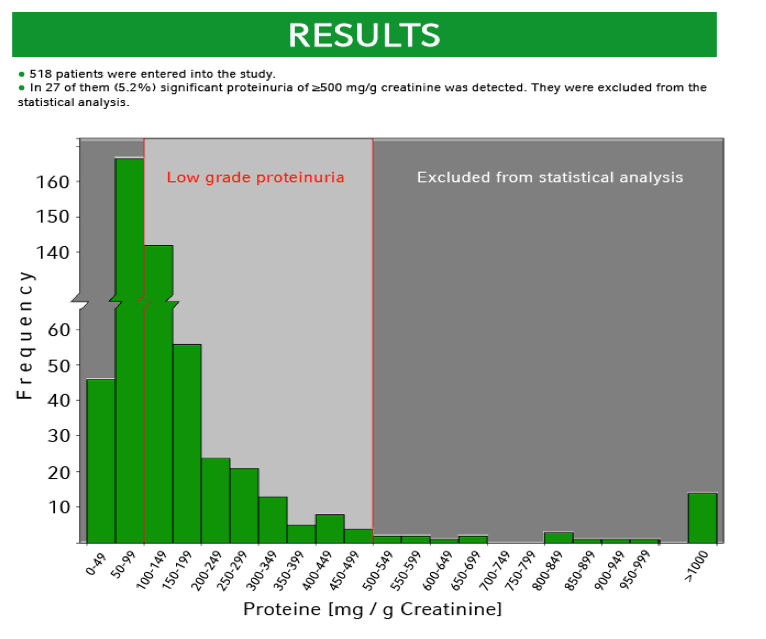
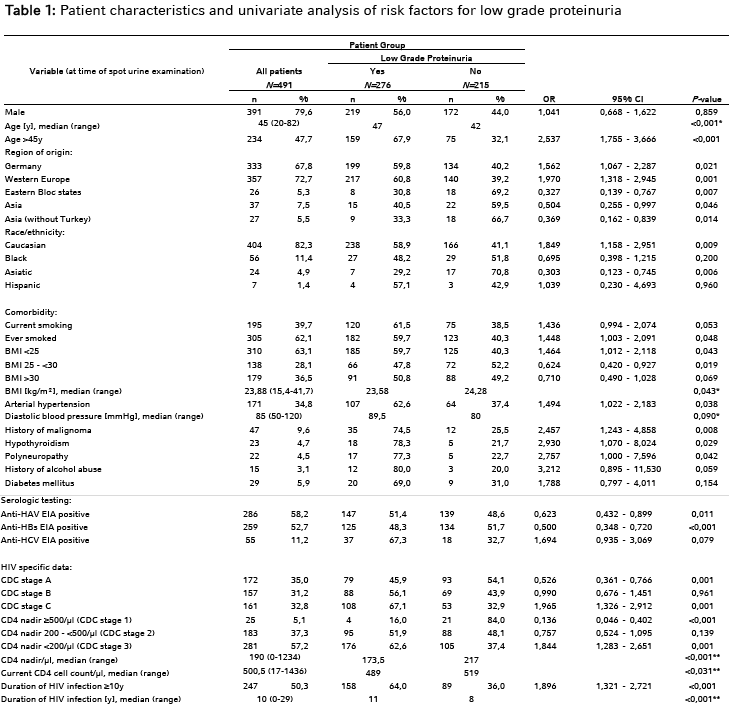
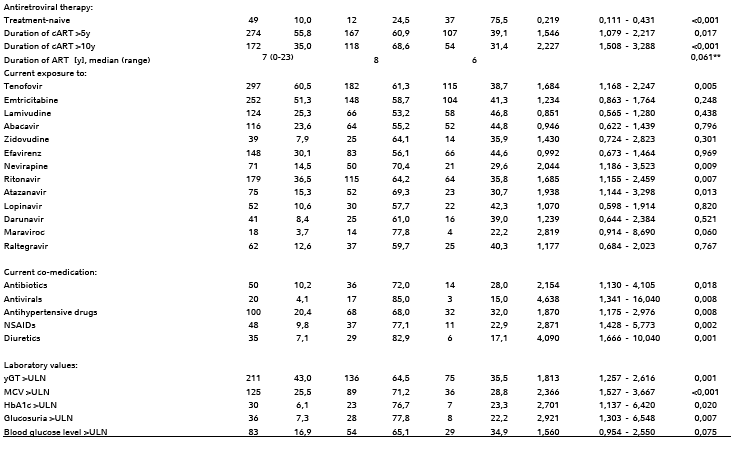
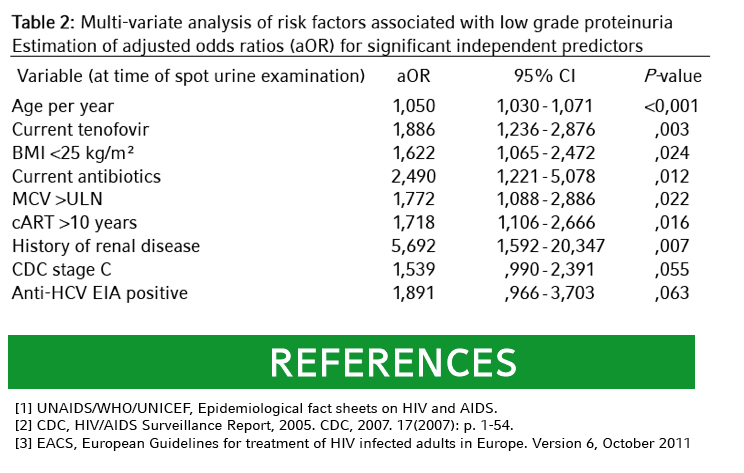
|
| |
|
 |
 |
|
|